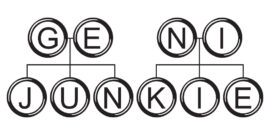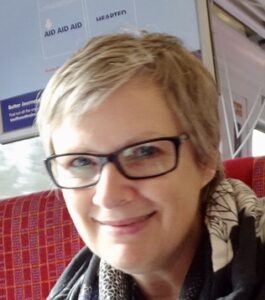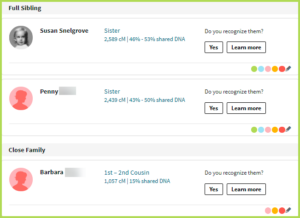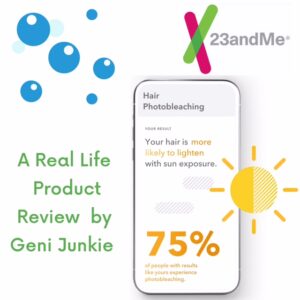In my last Blog Post, “Why Do a DNA Test?” I walked you through the reasons why you might want to get a DNA test done, and some good reasons why you might not. You’ve moved on to this Blog, so I guess you decided the answer is “Yes”! That’s terrific, because I think you will find exploring your DNA a lot of fun. Now I will guide you through the types of DNA tests there are, and which DNA testing company to choose.
So which company should you choose to do your DNA test? I haven’t used all them myself, so can’t do a fair company by company comparison for you. You can find charts on-line that give you the high level information on each and how they differ. But read on for my personal insights into some of the most popular ones I myself have used. To choose wisely you need to understand up front just what is important to you, and what is not. Don’t go by cost alone! The most important factor on which DNA test and which DNA testing company to choose is what you want to get out of it.
The various DNA testing companies offer the following types of DNA tests, all which involve a simple cheek swab or saliva sample:
- The standard is an Autosomal DNA Test, which can give you:
- Genetic Health Report
- Ancestral Heritage Map
- DNA “cousin matches”
- Y Chromosome Test
- Mitochondrial DNA (“mtDNA”) Test
So let’s look at each type of DNA test one at a time.
Genetic Health Report
Most people probably think of 23andMe for the health test, because they have been around a while and have excellent advertising. Ancestry and MyHeritage are newer to this field, and the product isn’t available everywhere yet. Living DNA (partner for FindMyPast) does a “wellbeing and fitness” report, but it’s not as extensive as the others. And CRI Genetics is another company that appears extremely scientific, but I am totally unfamiliar with them.
If you want a genetic health report, be sure to read all the details in advance of what genetic traits and conditions they will report on. If you don’t, you might find out something about your potential health that you actually didn’t want to know. For instance, my mother had late on-set Alzheimer’s, and some DNA testing companies test for the gene variant which is an influence in that disease. I decided not to do the 23andMe test because frankly I am nervous to know whether I carry that variant. Sometimes ignorance is bliss. Some companies also test for genetics related to certain cancers and other serious diseases. This could be very important to you if there is a family history.
So carefully review each genetic health testing company, because they don’t all test for the same conditions and traits. You obviously want to get key results that are important to you, and avoid ones you don’t want to know. I have also seen some critical articles lately, questioning the reliability of the results for certain newer players in the field. According to some reviewers, not all genetic health testing companies are created equal.
Heritage Map
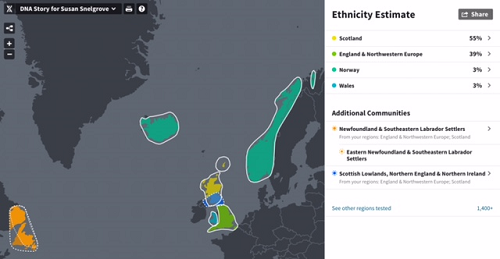
All the DNA testing companies provide your “cousin” matches and heritage breakdown. Your ancestral makeup can vary quite remarkably between the different testers based on their algorithms. And they do update them occasionally, so over time at Ancestry I became more Scottish than English and Irish. However on MyHeritage, I am 40% Scandinavian and somewhat Italian!
Other ancestral region predictions are very accurate, because Ancestry shows that I specifically have Newfoundland and Northern Ireland ancestors. I have read that CRI Genetics gives a very deep and distant breakdown of your ancestral regions, and this might be fascinating to you.
I find it all very interesting and a bit of fun to see where my ancestors presumably came from. But my heritage prediction isn’t something I take very seriously, given the inconsistencies between the companies. I’m sure their research into this will improve over time and hopefully become more detailed and accurate.
Your DNA “Cousin” Matches
For me the “Cousin” matches is what it’s all about! This is the reason why I did a DNA test, and it is your thousands of matches that will take you to the next level with your family tree building. Generally speaking, the size of the customer base of each provider will influence the number of matches you have when comparing companies. The sheer number of matches is super important to me, but maybe it won’t be to you.
I used Living DNA (FindMyPast) recently, and I did find their cousin matching disappointing. They are new to the game, so I had only a small amount of matches compared to the other companies. And more importantly, you can’t see the trees for the people you match, because this feature isn’t being introduced until later in 2021. For now, all you can see is the person’s user name, your % of shared DNA, predicted relationship, and their email. So for now, I found the matches weren’t very useful to me.
The area of DNA testing is rapidly growing, and new companies are entering the field all the time. It’s likely that other countries have their own local companies that I wouldn’t be aware of. So make sure you do your research before you buy. Your decision will probably be influenced by the type of reports you want. If you’re not interested in the health part, I would definitely concentrate on the merits of the tree building and research data capabilities of the DNA testing company. I highly recommend that you keep the two parts together for optimal ease of use.
The Special DNA Tests, or in other words, “Why do a Y?”
The Y chromosome and mitochondrial DNA (mtDNA) tests are special tests, and not usually of interest to the beginner. But you should be aware of them for later in your research, because they can definitely help you in unique ways. Two providers I will mention here are Living DNA (partner of FindMyPast) and FamilyTree DNA. These companies both do the typical autosomal DNA test I discussed above, as well as these special tests. There is a third company I am aware of, CRI Genetics, but I have no experience with them. There are likely others, as companies are entering the field all the time.
Simply put, the Y chromosome test helps trace the patriarchal lines of a man (and therefore his surname). The mtDNA helps trace the matriarchal line of both male and female testers. The Y test is particularly helpful for male adoptees. Because this is an advanced topic, I have written a separate Blog Post “How Special DNA Tests Can Benefit your Genealogy”. My brother and I did these two special tests with FamilyTree DNA, which I will discuss in that Blog. But given my experience with their poor tree building platform and no research data sets, if you are just getting the standard autosomal DNA test done, I think there are better choices for you than Family Tree DNA.
So Who Did I Choose for My DNA Test?
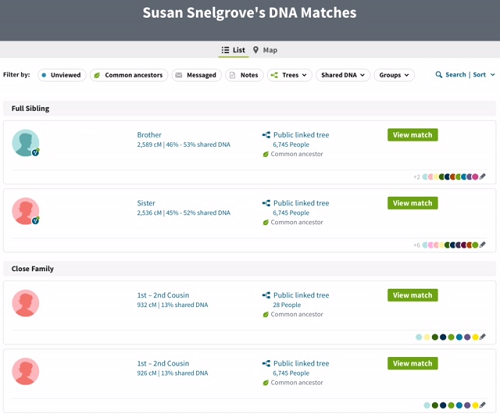
For my test I chose Ancestry, because they were at the forefront several years ago when I did it. And it really is the biggest company by way of “cousin matches”, because of their huge customer base. To put it in perspective, when I first got my DNA tested 8 years ago, I had 64 “fourth cousin” matches, which is considered a fairly close relative. Fast forward to now, and I have 1,600+ “fourth cousins” and 22,000 DNA matches in total. That rapid growth is an indication of how popular genealogy and DNA testing has become!
I find Ancestry’s product easy to use and they have excellent data sets for tree building. Their kit ordering process was easy and the results came quicker than predicted. I was okay with the price, and given all this, I am happy with my choice. I think it’s very important to have my DNA with the same company that I use to build my tree. Within Ancestry I can review my DNA matches, and then jump into the research records easily when something bears looking into. You don’t want to have to constantly jump back and forth between “Company A” for your DNA matches and “Company B” to manually add the people you find into your tree.
One DNA Test, Many Uploads Later…..
I hope all this information hasn’t made your choice seem overwhelming! If you are worried about making the wrong decision, don’t be. Luckily, many of these companies have made it easy to upload your DNA file to other providers, so you have lots of flexibility. Note that you can transfer your DNA file from Ancestry and 23andMe to another provider, but you are not able to upload from other providers to them. Once I found out that I could export my Ancestry DNA zip file, I did. More than once! I am after all, the Geni Junkie! If there’s more, I want it, especially if it’s free!
I have written the step by step instructions for you in my Blog Post, “How to Download and Transfer your DNA File“.
Think about it …. There is no point in taking a second DNA test, because all companies should theoretically get the exact same result. Your DNA is DNA! Why pay twice for a test? They make it simple for you to download your DNA data file. You then open a free account at another company, and upload your DNA file there. Easy peasy! You’ll get access to your DNA matches at that company, and be able to communicate with those “cousins”. You won’t be able to search the provider’s research records, unless you pay the subscription fee. But that’s ok, because you already have that capability with your own provider and all the other free and paid sites I have have mentioned. Or, you may find that you do like the other new site, and go ahead and buy a subscription. That’s what I did!
Why Do I Like MyHeritage DNA Testing Company So Much?
The first place I uploaded my Ancestry DNA file was MyHeritage. I did it simply because I wanted access to even more matches than being with just one site. But I stumbled across an unexpected benefit! With MyHeritage I get much different matches than I do with Ancestry. I find that Ancestry’s membership is really US/Canada focused. I don’t get that many matches with residents in the UK and Europe, where my original roots lie. MyHeritage on the other hand appears to be more popular with customers outside North America. So I have gotten some really illuminating matches with people from the UK, Europe, Scandinavia and Australia that aren’t even on the radar at Ancestry.
Plus, MyHeritage has the super benefit of being able to see your matches at a chromosomal level. Ancestry tells you how much DNA you have in common, and makes a prediction about your relationship. But MyHeritage and Family Tree DNA actually graphically shows you which chromosome and at what specific location you match. And as I have really gotten into my DNA research, I find this level of detail to be extremely important. With my recent discovery of a free on-line tool called DNA Painter, I can download the DNA in common with other users, and actually map my chromosomes.
Show Me Your Chromosomes (and I’ll Show you Mine)!
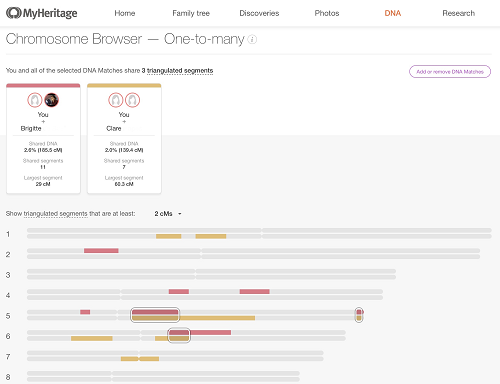
For example, the very first match on my MyHeritage list was a young woman in the Netherlands. She turned out to be the great granddaughter of my Irish grandfather’s brother (aka second cousin one time removed). When I downloaded our matching DNA into the DNA Painter program, I now know “oh those spots on Chromosomes 5 and 6 are McGuirk DNA”. And that is helpful when you run into other matches who you don’t know the connection to just by looking at their tree. If they match on the same place on Chromosome 5 or 6 as my Netherlands “cousin”, then I know that person has a McGuirk ancestor.
Now we are really getting into the nerdy part of DNA genetic genealogy. You may never get there, but I mention it because it is definitely one advantage to having my DNA data at a site other than Ancestry. Because alas, as strong a player as they are for almost every other criteria, the one place Ancestry falls down in my opinion is not providing your DNA information on a chromosomal level. Other companies also show your X chromosome matches, which again is helpful, because this gives insight into your matrilineal matches. I have so many puzzle pieces snapped in place with my Ancestry user connections, but I simply can’t take the next step and get them into my DNA painter project.
This very well might not matter to you at all. And it certainly shouldn’t deter you from choosing Ancestry. They are in fact my own #1 choice. But Ancestry if you are listening, please add this feature in the future. Your power users like me would really appreciate it!
If you are interested in the idea of the painting your chromosomes and other cool tools, you can check out my Blog post “DNA Painter – A Great Tool to Further Your Genealogy Research”.
Last But Not Least…. Gedmatch.com
I will tease you with a brief mention here of the free site Gedmatch.com, which allows people to upload their DNA files from any provider that they have tested with. So, it is a very large repository that allows you to access your matches from all DNA testing sites. This increases your match capabilities exponentially. It also has some very cool tricks and useful tools to help you with your DNA matches. There is so much to say about this wonderful site that I will have to make it the subject of a future Blog Post on its own.
Let’s Wrap these DNA Tests Up!
So there you have it. Now you know enough to understand which DNA test to choose, and to make a decision on which DNA testing company to choose it from. Order your test kit, and then get ready to spit or swab! You will learn about your ancestral heritage, some of it ancient, and you will find you have so many matches you will surely never get through them all. You might also learn about your genetic health or special DNA reports if you choose those options.
The one thing I take away when I look at my own 22,000+ matches is how the citizens of the world are so much more connected than we realize. Every single person that I match has a common ancestor to me, and when I look at all the different countries those people come from, it is truly amazing to behold.
Once you have your DNA test results in hand and literally thousands of matches, what do you do next? I am going to write another series of Blog Posts getting into the real nitty gritty details of successfully using your DNA matches to further your genealogy research. Then it gets really interesting! These Blog Posts will be a must read for you. I learned so much through trial and error with my own DNA results that my tips will save you time and make your investigations more fruitful, than stumbling along on your own.
Have fun and I wish you many happy discoveries!
Your Geni Junkie friend,
Susan
